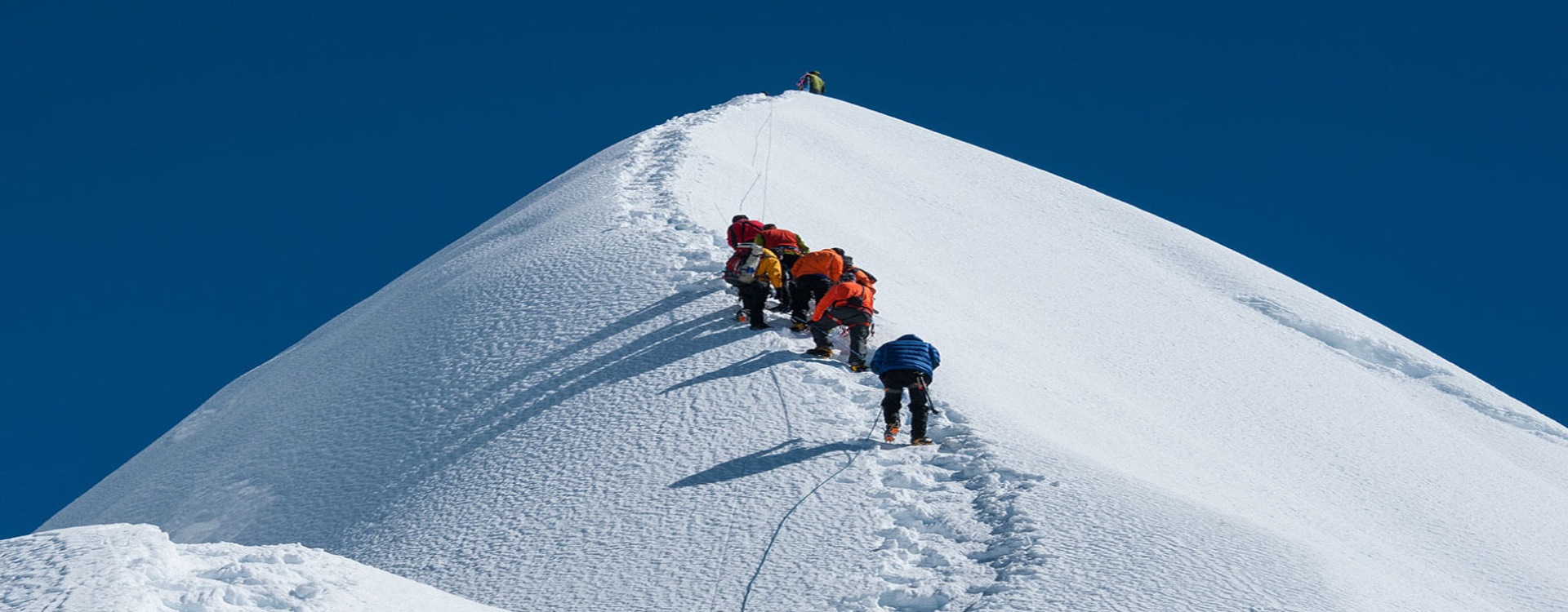Prepare to venture into the captivating world of the Himalayas, where the towering peaks, rich culture, and extraordinary climbing history await. Mera Peak, the highest trekking peak in Nepal, offers an unparalleled adventure. Located in the Solu Khumbu region, this climb encompasses everything from the vibrant city of Kathmandu to the serene mountain trails, ancient monasteries, and breathtaking vistas.
Imagine standing atop Mera Peak, surrounded by the world’s highest mountains, and experiencing the grandeur of the Himalayas. This region is renowned for its stunning beauty, blending the natural splendor with the unique culture of the Sherpa people. Each step of the journey is remarkable, from the bustling streets of Kathmandu to the peaceful paths leading to Mera Peak. This adventure is not just about reaching the summit; it’s about immersing yourself in the Himalayan way of life, interacting with locals, and soaking in the region’s distinctive atmosphere. Whether trekking through dense forests, crossing high passes, or visiting historic gompas, the route to Mera Peak offers a sensory feast and an unforgettable experience.
Table of Contents
Why Mera Peak?
Mera Peak is a sought-after destination for climbers worldwide. Standing at 6,476 meters (21,247 feet), it is the highest trekking peak in Nepal. The climb is challenging yet accessible, making it an excellent goal for those looking to test their abilities at high altitude.
One of the major attractions of Mera Peak is its accessibility to climbers of varying skill levels. While it requires physical fitness and basic mountaineering skills, it does not demand the extreme expertise needed for peaks like Everest or K2. Thus, it serves as a great starting point for those aiming to progress to more challenging climbs. The route to Mera Peak takes you through some of the most magnificent landscapes in the Himalayas, including lush valleys, serene lakes, and imposing glaciers. As you ascend, you are rewarded with panoramic views of five of the world’s highest peaks—Everest, Lhotse, Makalu, Kangchenjunga, and Cho Oyu—providing a sense of awe and accomplishment that is hard to match.
A Historical Gem
Mera Peak, though not as historically famous as some of its neighboring giants, holds its own charm and significance. The peak was first scaled in 1953, the same year Sir Edmund Hillary and Tenzing Norgay made their historic ascent of Everest. This historical backdrop connects modern climbers to a rich legacy of exploration and adventure, adding depth to the experience of climbing Mera Peak.
Understanding Mera Peak’s historical significance allows you to appreciate the challenges and triumphs of those who climbed before you. This knowledge enriches your own ascent, making you part of a long tradition of mountaineering in the Himalayas.
Breathtaking Scenery
Climbing Mera Peak is a visual delight, surrounded by glaciers and peaks rising between 7,000 and 8,000 meters high. The trek offers breathtaking alpine scenery and incredible views of Mount Everest and other towering giants from the summit.
The journey itself is a visual feast, with every turn revealing new and stunning vistas. Trekking through the Hinku Valley, you will encounter vibrant rhododendron forests, suspension bridges over roaring rivers, and traditional Sherpa villages. As you climb higher, the landscape transitions to stark alpine terrain, with glaciers, icefalls, and towering peaks forming a dramatic backdrop. This beautiful landscape is not just a visual treat but also a powerful reminder of nature’s majesty.
The Climbing Experience
Climbing Mera Peak is about more than reaching the summit; it’s about the journey and the experiences along the way. The ascent combines trekking and climbing, offering adventurers a comprehensive experience. The climb involves navigating glaciers, ascending a steep headwall, and traversing crevasses.
The climb starts with a trek through the picturesque Hinku Valley, where you acclimatize and prepare for higher elevations. As you approach Mera Peak Base Camp, the terrain becomes more challenging, with steep ascents and rugged trails. The final push to the summit involves climbing a steep ice headwall, using fixed ropes and technical skills. This section tests your physical and mental stamina, as you navigate ice and snow, often in freezing temperatures and high winds. Reaching the summit is a moment of triumph, where your efforts are rewarded with breathtaking views of the Himalayas. The experience of climbing Mera Peak is a blend of adventure, challenge, and the sheer joy of being in one of the most beautiful places on Earth.
Preparation and Training: Key to Success
Climbing Mera Peak requires proper preparation and training. Familiarity with fixed-line mountaineering techniques, rappelling, and efficient movement on snow and ice is essential. Training should focus on building cardiovascular endurance, strength, and technical climbing skills.
Preparation for Mera Peak should begin several months before the climb. Cardiovascular activities such as running, cycling, and swimming help build the stamina needed for long days of trekking and climbing. Strength training, especially for the legs and core, helps meet the physical demands of the ascent. Technical training, including the use of crampons, ice axes, and fixed ropes, is crucial for safety and efficiency. Practicing these skills in a controlled environment, such as a climbing gym or a mountaineering course, can boost your confidence and competence. Mental preparation is equally important, as high-altitude climbing can be mentally challenging. Developing a positive mindset and coping strategies for dealing with stress, fatigue, and altitude can significantly enhance your overall experience and success.
Base Camp and High Camp: Stepping Stones to the Summit
Final preparations take place at Mera Peak Base Camp, situated at 5,300 meters. High Camp at 5,800 meters provides a better acclimatization and a safer ascent. Training includes gear checks and practice with harnesses and crampons to ensure comfort and efficiency on summit night.
Base Camp serves as the staging area for the final ascent. Climbers perform full gear checks and practice using their equipment in the environment they will encounter on the summit push. This includes practice with harnesses, crampons, and fixed lines. The time spent at Base Camp is crucial for acclimatization, allowing your body to adjust to the lower oxygen levels at high elevations. Moving to High Camp involves a challenging trek but better prepares you for the summit attempt. High Camp is more exposed, providing a taste of the conditions you will face on summit night. The higher altitude aids in further acclimatization, preparing climbers physically and mentally for the final push to the summit. These camps are more than just rest stops; they are essential steps in the acclimatization process and provide the opportunity to refine skills and prepare mentally for the challenge ahead.
Gearing Up for Summit Night
Having the right gear is crucial for staying warm and safe during the climb. Double mountaineering boots, merino base layers, down vests, and Gore-Tex shells are essential. Summit night starts early, with a challenging trek across rocky terrain to the crampon point.
Climbing Mera Peak requires specialized gear designed to withstand the extreme conditions of high-altitude climbing. Double mountaineering boots provide adequate insulation and support, while merino wool base layers offer warmth and moisture-wicking properties. Mid-layers, such as down vests or jackets, add insulation, while outer layers, like Gore-Tex shells, protect against wind and snow. Insulated gloves, hats, and face masks are essential to prevent frostbite. The climb begins early in the morning to take advantage of the typically stable weather conditions at dawn. Climbers will need headlamps to navigate the rocky terrain in the dark.
The Headwall: Final Ascent
Climbers will navigate the headwall using fixed lines. This section requires patience, breath control, and efficient gear use. The final ascent to the summit can take up to an hour and a half, with the reward of stunning panoramic views.
The headwall of Mera Peak is a steep and challenging section that tests your climbing skills and physical endurance. Climbers use fixed ropes for safety on the steep ice and snow slopes. Proper technique is crucial, as you need to control your breathing, maintain a steady pace, and use your ice axe and crampons effectively. This section can be mentally demanding due to the altitude and exertion. However, the reward is immense. As you near the summit, the panoramic views of the surrounding peaks, including Everest, Lhotse, and Makalu, are breathtaking. The sense of accomplishment when you stand on the summit, gazing out over the Himalayas, is something climbers cherish for a lifetime.
Getting Back Down: A Critical Phase
Descending safely is critical. The team will rappel down the headwall and return to High Camp or Base Camp, depending on the timing. Backup personnel and resources facilitate a smooth transition back. Safe descent techniques are as important as climbing skills, requiring focus and careful navigation to avoid accidents.
Descending Mera Peak is often underestimated, yet it is a crucial part of the climb. After the exhilaration of reaching the summit, climbers must focus on safely finding their way back down. The descent begins with rappelling down the headwall, which requires technical skill and concentration. Once past the headwall, the terrain becomes less steep, but climbers must remain cautious as fatigue and altitude can increase the risk of slips and falls. Returning to High Camp or Base Camp involves retracing your steps through steep terrain and glaciers. Backup personnel and resources, such as additional guides and porters, are on hand to assist with any issues that may arise during the descent.
Best Time to Climb Mera Peak
The best time to climb Mera Peak is during the pre-monsoon (March to May) and post-monsoon (September to November) seasons. These periods offer stable weather and clear skies, providing optimal climbing conditions.
Choosing the right season for your climb is crucial. The pre-monsoon season from March to May and
the post-monsoon season from September to November offer the best weather conditions for climbing Mera Peak. During these periods, the weather is generally stable, with clear skies and moderate temperatures. This ensures safer climbing conditions and better visibility, allowing you to fully enjoy the stunning views from the summit. Avoiding the monsoon season is essential, as heavy rains and poor visibility can make the climb dangerous and challenging.
Conclusion: A Journey of a Lifetime
Climbing Mera Peak is a journey of discovery, challenge, and achievement. From the rich cultural experiences in Kathmandu to the exhilaration of reaching the summit, every step of the adventure offers something unique. Proper preparation, training, and a love for the mountains are essential to make this journey a success. Mera Peak promises an unforgettable experience, blending the thrill of high-altitude climbing with the rich cultural tapestry of the Himalayas.
Whether you are an experienced climber looking for your next challenge or an adventurous spirit seeking an unforgettable experience, Mera Peak is an exceptional destination. This climb offers a perfect blend of adventure, cultural immersion, and natural beauty, making it a journey of a lifetime.

